top of page

April, 2024
Carbon Catchers
AR/VR
Learning Experience Design
Product Design
An AR Scavenger Hunt designed to educate participants about the carbon cycle and enhance environmental awareness.
Officially launched at the Earth Festival at the American Museum of Natural History on April 27, 2024.
Product Manager: Eozin Che, Lead Creative Technologist at the American Museum of Natural History, Eric Chen
UIUX Design: Yuling Zhou, Vicky Yang
Engineers: Marsha Fabiola, Lexin Xiong, Samia Menon
Writer: Laura Moustakerski
The Launch Day:
Earth Fest 2024 @ American Museum of Natural History
Over 2,000 users experienced our project on launch day, predominantly parents and children. Seeing the joy on the faces of both children and their parents was incredibly fulfilling. We also captured some valuable photos from the event.
The Challenge
Design the American Museum of Natural History's first-ever Augmented Reality (AR) experience within 10 weeks, pioneering AR design in its 155-year history.
Our project goal was to design an AR scavenger hunt experience for Earth Day 2024 in the Hall of Ocean Life. We aimed to bring the museum's dioramas to life with augmented reality(AR) and show how marine animals help store carbon in the ocean ecosystem.
Our high-level goals were to:
-
Create playable interaction to show the users what roles animals play in the carbon cycle.
-
Make it fast and easy to scan and experience for everyone who comes to the event.
-
Incorporate educational content into the experience in an intriguing and captivating manner, allowing users to absorb environmental knowledge effortlessly and engagingly.
Timeline
From 0 to launch in 10 weeks: Executing a high-impact design project under a tight deadline.

My Role
I led the design of the AR Scavenger Hunt experience between February 2024 and May 2024. I collaborated with two other designers on the Landing page, menu, AR scan features, and payoff animations. In addition, I worked alongside two Product Managers, three Engineers, and a Content Writer.
The experience launched on the Earth Festival at the American Museum of Natural History on April 27th, 2024.
Kickoff: Early insight of the field
Initially uncertain about AR's compatibility with museum dioramas, I collaborated with the product manager to pilot AR technology on the Hall of Ocean Life dioramas using The 8th Wall. We chose six diorama stations to design and develop the AR Scavenger Hunt Experience: Blue Whale, Manatee, Tuna, Coral Reef, Sea Otter, and Sargasso Sea.
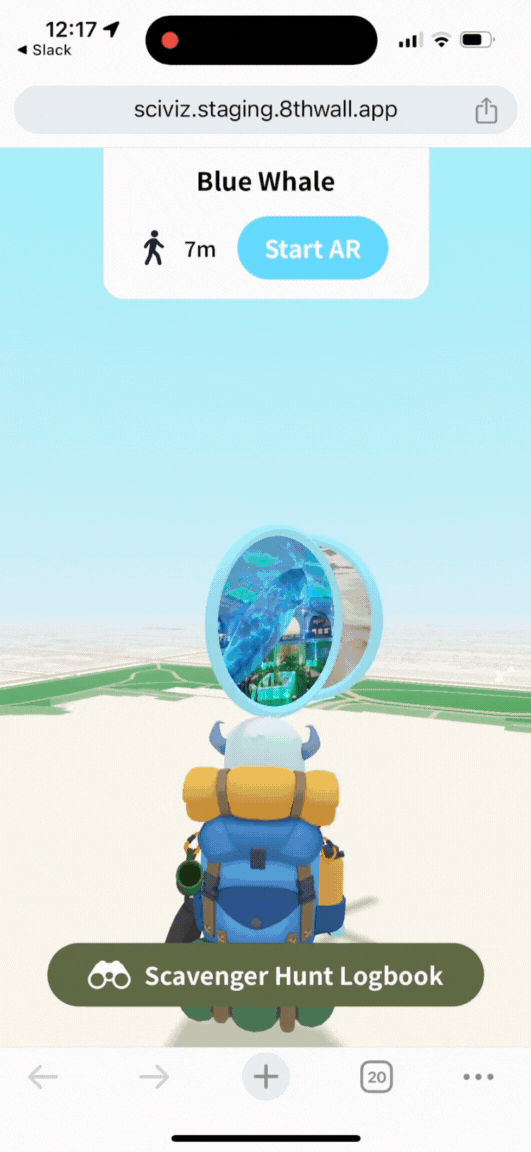
In the early design stage, we used an AR template from 8th Wall and an interactive map to guide users to each diorama. The designs were basic, lacking instructional content on the carbon cycle and interaction with animal dioramas.
The first testing version created by the 8th wall
Design and Refinements
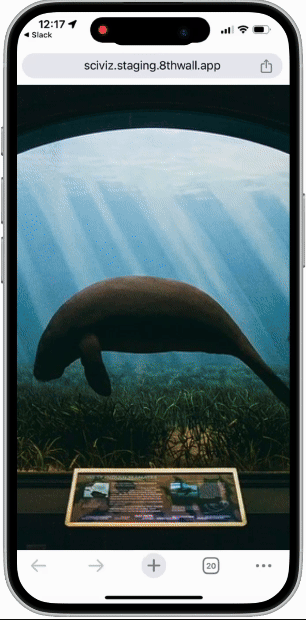
After the field test, we redesigned all the experience prototypes, including landing pages, the main menu, and AR interaction prototypes.
To enhance interactivity, we designed an experience where users can drag around the ocean animals after they scan chosen dioramas to explore their roles in the carbon cycle. For instance, Manatees contribute to the carbon cycle by consuming seagrass. They eat up to 150 pounds of seagrass a day. The seagrass grows back, absorbing more CO2.
First Version of User Flow of Manatee Diorama Station
However, we found users don’t want to read long text about the carbon cycle without animations and pictures, and the AR experience cannot effectively educate users.
Moreover, users prefer not to read texts after the gameplay session. Instead, they tend to proceed to the next station immediately.
“I don’t feel I’m learning when I play with the Manatee, and I just skip long texts, especially after I finish the gameplay process.”
Said one of our teammates after he had experienced the first version.
Iterations

We enhanced the AR learning experience by presenting scientific content through concise text and animations before gameplay, ensuring users engage with educational material.
This setup prevents users from skipping the learning phase and integrates fun animations to maintain interest and improve comprehension.
Core Interaction:
A Manatee eats seagrass. More seagrass grow back and absorb more CO2.
Second Iteration of User Flow of Manatee Diorama Station
We designed the Sea Otter and Tuna stations in the same way.
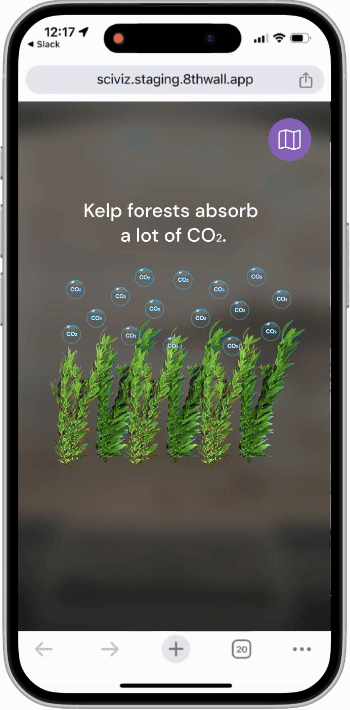
Core Interaction:
Sea otter consume sea urchins to help carbon cycle. Sea urchins eat kelp and destroy the kelp forest, while Kelp forests absorb a lot of CO2.
Second Iteration of User Flow of Sea Otter Diorama Station
A/B Testing: Tuna Station
We conducted A/B testing at the Tuna station, comparing two groups distinguished by the number of flying fish present. One group experienced a scenario with just one flying fish and one tuna, while the other group had a school of flying fish alongside a tuna.
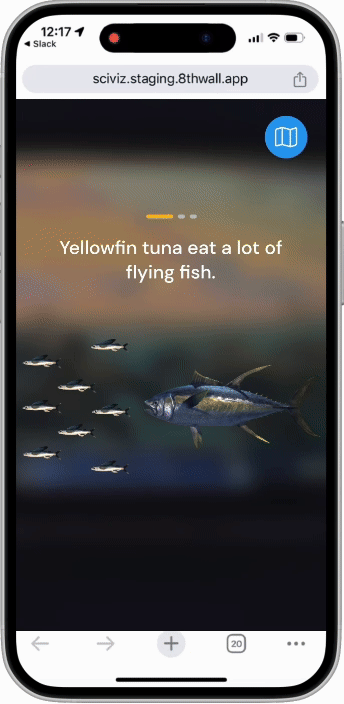
Tuna Diorama Diorama Testing Station A
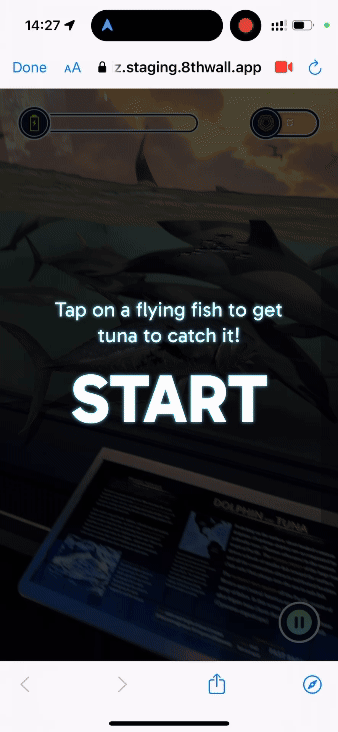
Tuna Diorama Diorama Testing Station B
Core Interaction:
Yellowfin tuna eat a lot of flying fish. Carbon in the smaller fish is stored in the bigger fish.
Iterations of MENU
Given that there are five stations, we designed the main menu to resemble a treasure map, enhancing playability and encouraging users to explore the entire experience.

First Version:
Lightened Progress
Icons light up after each station, and the progress bar fills after every two stations, motivating users to explore all stations.

Second Version:
Button and Map
Enhanced the "Start AR" button to appear more clickable and updated the map with detailed stairs and station locations to encourage users to explore further.

Third Version:
Responsive Click
Added a location hotspot, updated the progress bar, and placed a visual bubble behind coins for station selection. Station names now appear above when selected.

Final Version:
Cut Redundancy
Removed the location hotspot, redundant progress bar, and Sargasso Sea station, and deleted name bubbles to increase challenge. Also, replaced the generated icons.
Test and Refine: User Testing
On March 27th, 2024, we conducted user testing at the American Museum of Natural History, engaging 13 adults and 6 children to evaluate the Manatee, Sea Otter, and Tuna stations. This session aimed to refine our design and gather actionable insights from our volunteers. We got valuable feedback from the user testing.

Photo of the user testing day
An adult participant expressed confusion during the session, stating,
"I don't know how to proceed to the next page or interact with the AR animal models. I even tried dragging the progress bar to move to the next step."
Issues

Introductory Instructions
-
Users were unclear about needing to swipe to proceed through instructional pages;
-
Lacked clear instructions on how to properly interact with the AR elements, specifically needing guidance on mechanics like press, hold, and drag.

Usability Enhancement
-
Users feel a need to refine model sizes and placements for better diorama alignment.
-
Need to enhance colors, contrasts, and size for easier interaction and improve the detection of smaller creatures like small fishes.
-
Prefer a school of flying fish for easier interaction and more accurate responses, as a single small fish can be hard to click on.

Technology Issues
-
There were several challenges with AR elements not appearing after scanning, overly zoomed-in, or misaligned with the intended scenery. Additionally, smaller elements like flying fish were difficult to spot due to poor color contrast and size.

Instructional Content and Terminology
-
There is a need for clearer definitions and possibly simplifying complex scientific terms for better user understanding. Visual aids might also be beneficial in helping users identify and understand specific marine life and ecological concepts.
Second Iteration
After user testing, we refined our design before the launch. Our focus was on enhancing usability, including adding intuitive instructions, refining colors, fonts, and model sizes, addressing technological issues, and improving the instructional content. We also finished developing the blue whale station and coral reef station.

Final Version

Landing pages:
Make the interaction intuitive.
Making users aware that swipes lead to the next page.
Blue Whale Station
Manatee Station
Tuna Station
Sea Otter Station
Coral Reef Station
Instructional Video
Our team also created a cartoon video explaining the carbon cycle, displayed in the Hall of Ocean Life alongside the launch of our AR scavenger hunt. The video provided essential background knowledge to serve an instructional purpose.
Scavenger Hunt Guide


QR Code Designs
We designed QR codes for each diorama station, allowing users to scan and access the AR experiences.



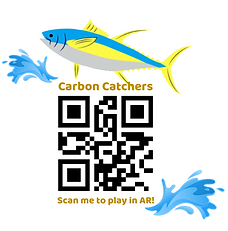

Our Team on the Launch Day
Reflection and Next Steps
Due to the short design and development period, we still had some unsolved issues. On launch day, we encountered several technological setbacks. Delayed transitions to subsequent pages post-scan were particularly problematic, compounded by the overload of simultaneous users on the same WI-FI network, which significantly slowed internet speeds. This resulted in some attendees discontinuing their participation before completing all the stations. Furthermore, the AR models at the sea otter and tuna stations did not perform smoothly, and models don’t move with camera. Instead, models only pop up and stay at certain spot.
Moving forward, addressing these technological issues is crucial. Enhancing network infrastructure to support high user volumes and optimizing the performance of AR models will substantially improve the user experience in future events.
bottom of page



